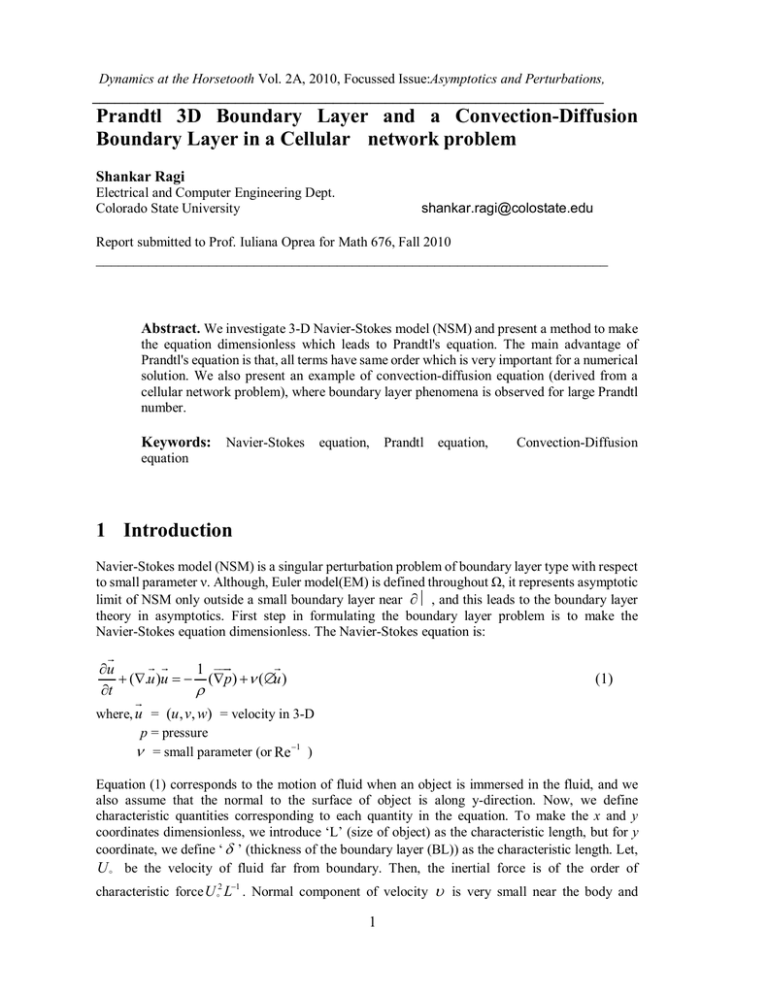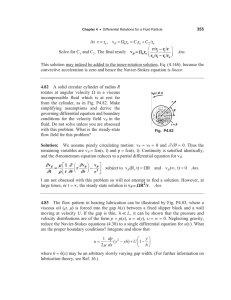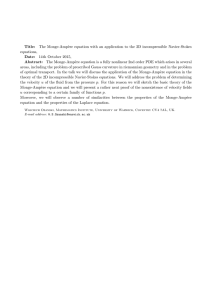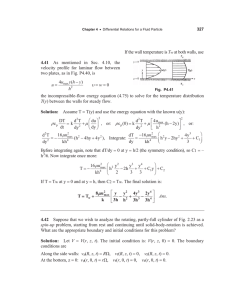Prandtl 3D Boundary Layer and ... Boundary Layer in a Cellular network problem
advertisement

Dynamics at the Horsetooth Vol. 2A, 2010, Focussed Issue:Asymptotics and Perturbations, ____________________________________________________________________ Prandtl 3D Boundary Layer and a Convection-Diffusion Boundary Layer in a Cellular network problem Shankar Ragi Electrical and Computer Engineering Dept. Colorado State University shankar.ragi@colostate.edu Report submitted to Prof. Iuliana Oprea for Math 676, Fall 2010 ____________________________________________________________________ Abstract. We investigate 3-D Navier-Stokes model (NSM) and present a method to make the equation dimensionless which leads to Prandtl's equation. The main advantage of Prandtl's equation is that, all terms have same order which is very important for a numerical solution. We also present an example of convection-diffusion equation (derived from a cellular network problem), where boundary layer phenomena is observed for large Prandtl number. Keywords: Navier-Stokes equation, Prandtl equation, Convection-Diffusion equation 1 Introduction Navier-Stokes model (NSM) is a singular perturbation problem of boundary layer type with respect to small parameter ν. Although, Euler model(EM) is defined throughout Ω, it represents asymptotic limit of NSM only outside a small boundary layer near ∂Ω , and this leads to the boundary layer theory in asymptotics. First step in formulating the boundary layer problem is to make the Navier-Stokes equation dimensionless. The Navier-Stokes equation is: ∂u 1 + (∇.u )u = − (∇p) + ν (∆u ) ∂t ρ where, u = (u , v, w) = velocity in 3-D (1) p = pressure ν = small parameter (or Re −1 ) Equation (1) corresponds to the motion of fluid when an object is immersed in the fluid, and we also assume that the normal to the surface of object is along y-direction. Now, we define characteristic quantities corresponding to each quantity in the equation. To make the x and y coordinates dimensionless, we introduce ‘L’ (size of object) as the characteristic length, but for y coordinate, we define ‘ δ ’ (thickness of the boundary layer (BL)) as the characteristic length. Let, U ∞ be the velocity of fluid far from boundary. Then, the inertial force is of the order of characteristic force U ∞2 L−1 . Normal component of velocity υ is very small near the body and 1 therefore it has the order δ .The characteristic time is assumed to be LU ∞ −1 (large-scale time). We introduce the following dimensionless quantities: u = U ∞ u ' , υ = δ L−1U ∞υ ' , w = U ∞ w' , x = Lx ' , y = δ y ' , z = Lz ' (2) Therefore the x-component of the inertial force is: ∂u ' ∂u ∂u ∂u ∂u ∂u ' ∂u ' ∂u ' + u +υ + w = U ∞2 L−1 + u ' ' + υ ' ' + w' ' ∂t ∂x ∂y ∂z ∂x ∂y ∂z ∂t (3) Similarly, the x-component of viscous force is: 2 2 2 ' ∂ 2u ∂ 2u ∂ 2 u ∂ 2u ' ∂ 2u ' δ −2 ∂ u δ v 2 + 2 + 2 = vU ∞δ '2 + '2 + '2 ∂y ∂z ∂z L ∂x ∂x L ∂y (4) In the boundary layer, the ratio of inertial forces to viscous forces is U ∞2 L−1 U ∞ L δ = ~ 1 as v → 0 vU ∞δ −2 v L 2 (5) Equation (5) shows that, in the boundary layer the inertial and viscous forces are of same order if: δ ~ v1/ 2 L1/ 2U ∞−1/ 2 as v → 0 ‘or’ δ ~ v1/ 2 δ ~ Re −1/ 2 ‘or’ as v → 0 as Re → ∞ Therefore, outside the boundary layer, Reynolds number (ratio of dominant terms of Inertial and −1 viscous forces) is Re = U ∞ Lv and it tends to ∞ as v → 0 , while in the boundary layer the −1 appropriate Reynolds number is Re1 = U ∞ Lv δ L 2 and Re1 ~ 1 as v → 0 . In fluid flows the forces have different orders in different regions. Prandtl is the first person to formulate this mathematically. According to Prandtl’s hypothesis, the inertial forces are much greater than the viscous forces outside the boundary layer, whereas inside the layer they have same order. Prandtl model (PM) give the first asymptotic approximation of NSM for Re → ∞ . Therefore, the pair Pm and Em together gives the asymptotic approximation of NSM throughout Ω for Re → ∞ . 2 Derivation of Prandtl’s Equation We compare the orders of the coefficients of the dimensionless terms in Navier-Stokes equations. Orders of individual terms of Navier-Stokes equation are given below: ∂u U∞ ~ = U ∞2 L−1 , −1 ∂t LU ∞ u ∂u ∂u ~ δ L−1U ∞U ∞δ −1 = U ∞2 L−1 , ~ U ∞2 L−1 , υ ∂x ∂y 1 ∂p 1 ~ ρU ∞2 L−1 = U ∞2 L−1 , ρ ∂x ρ w ∂u ~ U ∞2 L−1 , ∂z ∂ 2u δ v 2 ~ U ∞ Lδ 2 L−2U ∞ L− 2 = U ∞2 L−1 , ∂x L 2 2 v ∂ 2u ~ U ∞ Lδ 2 L−2U ∞δ −2 = U ∞2 L−1 , 2 ∂y ∂ 2u δ ~ U ∞ Lδ 2 L−2U ∞ L−2 = U ∞2 L−1 , 2 ∂z L 2 v Therefore, the x-component of the Navier-Stokes equation written in dimensionless form is 2 2 ' ' ' ∂u ' ∂p ' 1 ∂ 2u ' δ ∂ 2u ' ∂ 2u ' δ ' ∂u ' ∂u ' ∂u + u ' +υ ' + w ' = − ' + + + ∂t ' ∂x ∂y ∂z ∂x Re ∂x'2 L ∂y '2 ∂z '2 L (6) We obtain Prandtl’s equation by retaining the dominant terms (i.e., of order O(1) for Re tending to infinity) in the above equation: ' ' ' ∂u ' ∂p ' 1 ∂ 2u ' ' ∂u ' ∂u ' ∂u + u ' +υ ' + w ' = − ' + ∂t ' ∂x ∂y ∂z ∂x Re ∂y '2 (7) The advantage of the above equation over Navier-Stokes equation is that, all terms have same order. The z projection of the velocity is similar to the x projection. The y projection of velocity is given below with order of each term: ∂ 2υ ∂ 2υ ∂ 2υ ∂υ ∂υ ∂υ ∂υ 1 ∂p +u +υ +w =− +v 2 + 2 + 2 ∂t ∂x ∂y ∂z ∂y ∂z ρ ∂y ∂x δ 1δ δ 1 1δ δ2 δ δ −1 δ (8) 3 Outer and Inner Asymptotic Expansions of NSM for large Re To specify outer and inner expansions, we have to choose a small mathematical parameter ε > 0 to be a function of Reynolds number Re in NSM. Since, we are observing asymptotics when Re → ∞ , we assume ε = Re −1/ 2 , so that when Re → ∞ ε → 0 . Therefore, the outer expansions for velocity vector and pressure are: u ~ U 0 + ε U1 + ...... , p ~ P0 + ε P1 + ...... The inner expansion as ε → 0 is given by: u ~ u0 + ε u1 + ...... , υ ~ ευ0 + ε 2υ1 + ...... , w ~ w0 + ε w1 + ...... p ~ p0 + ε p1 + ...... , ∂p ∂p0 ∂p ∂p ∂p ∂p0 ∂p ∂p ∂p ~ + ε 1 + ...... ~ ε 2 1 + ε 3 3 ...... ~ + ε 1 + ...... ∂x ∂x ∂x ∂y ∂y ∂z ∂z , ∂y , ∂z Equation (8) implies that ∂p0 ∂p1 and ∂y ∂y do not appear in the expansion of ∂p . Using these ∂y expansions, we can derive models of different orders of outer and inner asymptotic approximation of the NSm for large Re. 3 4 Convection-Diffusion Equation (an example from cellular networks) In this section, we provide an example of Convection-Diffusion equation derived from cellular network [2]. We noticed that, convective velocity approaching to infinity gives rise to a boundary layer problem. The Convection-Diffusion (2-D) equation [3], which was derived from application of PDEs in cellular networks, is given below: ∂ 2q ∂q ∂ 2q ∂q ∂q = D + +υx +υy + g ( x, y) 2 2 ∂t ∂y ∂x ∂y ∂x (9 ) Instead of solving 2-D equation, we will solve 1-D equation (since, 1-D equation looks much simpler) and if this is successful, we can extend it to 2-D. Convection-Diffusion equation in 1-D is: ∂q ∂ 2q ∂q = D +υ + g ( x) 2 ∂t ∂x ∂x (1 0 ) where, q: a temporal and spatial function i.e., q(x,t) D: diffusion constant = 0.5 (for cellular network example) v: convective velocity (tends to infinity in our example) g(x): spatial function We restrict the PDE’s spatial domain to an interval on real line, in our example we assumed that x ∈ [0,1] , and also t ∈ [0, T ] for some T ∈ ℝ + ( x − 0.5)2 Boundary Conditions: q(0,t) = q(1,t) = 0; q( x, 0) = exp − 2 Simulation results We used COMSOL (a PDE solver) to solve the above 1-D convection-diffusion equation for various velocities. When velocity is large compared to diffusion constant, we observe an accumulation near x=0 (Fig. 3, Fig. 4, Fig. 5), thus giving rise to a boundary layer problem. As, one can see from the figures, perturbed solutions (Fig. 1, Fig. 2, Fig. 3, Fig. 4, Fig. 5) look very much different from unperturbed solution (Fig. 6). 4 Fig 1: Plot of PDE with Fig 2: Plot with Diffusion coefficient=0.5, Velocity=1 (Peak Value ‘or’ Ymax = 0.23) Diffusion coefficient=0.5, Velocity=5 5 (Peak value = 0.13) Fig 3: Plot with Diffusion coefficient=0.5, Velocity=15 Fig 4: Plot with Diffusion coefficient=0.5, Velocity=25 6 (Peak Value = 0.05) (Peak Value = 0.035) Fig 5: Plot with Diffusion coefficient=0.5, Velocity=100 Fig 6: Plot with Diffusion coefficient=0.5, Velocity=10000 7 (Peak value = 0.012) (Peak value = 10^-3) 5 Conclusions We presented the method of making Navier-Stokes equation dimensionless, which leads to Prandtl equation. The main advantage of Prandtl equation is that, all terms in the equation have same order, which is very important for numerical solution. Prandtl’s model and Euler model together represent the asymptotic solution for Nsm for Re → ∞ . We also presented an example of Convection-Diffusion equation (derived from cellular networks problems), which is a boundary layer problem for large Prandtl number. 6 References [1] K. D. Wong, C. W. Gin, R. Rajeswari, W. L. Woon, and E. K. P. Chong, "Feasibility of a PDE-based teletraffic model for cellular networks,". Proceedings of the International Conference on Intelligent Advanced Systems (ICIAS2007), Kuala Lumpur, Malaysia 11, 25-28, 2007. [2] Chapter 4 “Models of asymptotic approximation of the Navier-Stokes model” from the book ‘Asymptotic Treatment of Differential Equations’-Adelina Georgescu [3] Shankar Ragi, Edwin K. P. Chong, “Application of PDEs in 2D cellular networks”. (PhD Thesis, in progress) 8






